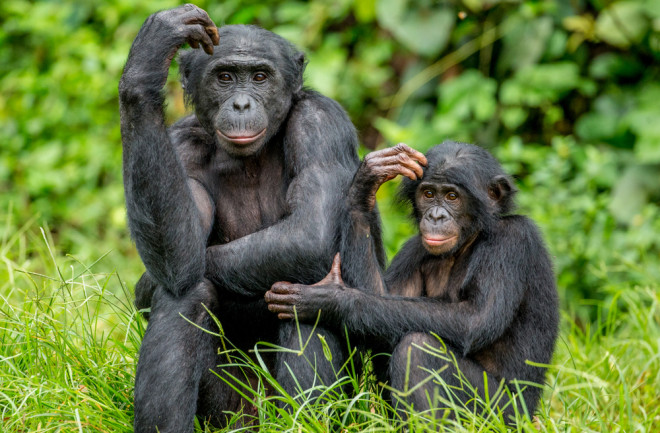As much as we like to think of ourselves as superior, humans are animals. We descended from a common ancestor of humans, shared with what became chimpanzees and bonobos between 6 and 8 million years ago. Though we’ve evolved since then, we’re still 98.8 percent the same as chimpanzees and bonobos. Humans and monkeys are so much alike that documenting our similarities is much easier than listing our few differences.
Shared Use of Tools
According to Stephanie Poindexter, a primatologist at The State University of New York at Buffalo, the more we look at monkeys and humans, the more we find that we’re largely the same. Tool use is one of the most obvious indications. “We used to think that being able to manipulate the environment was uniquely human, and now we know that chimpanzees use all sorts of tools,” she says.
Capuchin Monkeys
Additionally, capuchin monkeys have also been known to use tools. An August 2018 study published in the Royal Society of Science documented tool use within a population of white-faced capuchins in Coiba National Park, Panama. “We found that capuchins habitually use stone tools to open a variety of food resources, including hermit crabs and Halloween crabs,” write the study authors. Researchers also found that capuchins used coconuts to eat marine snails.
But while many primates have mastered ways of manipulating the environment, says Poindexter, humans have a much more extensive “built environment” full of artificial structures.
Read More: 7 Animals That Use Tools in Innovative Ways
Pair-living Primates
Humans are also “pair-living primates,” meaning that we tend to pair off and have children. But we’re far from alone in this social structure.
Titi Monkeys
Titi monkeys, owl monkeys, tamarins and gibbons are all characterized by a pair-living social system.
Like humans, among titi monkeys, they have one mate they stay with their entire life. They are of 3 to 5 percent of mammals in general that mate for life and they can become distressed when they're away from their partner.
Read More: Female Monkeys Live Longer If They Have a Social Life
Fission Fusion Social Structures
Monkeys, like humans, make friends and socialize. This means that they’re better friends with certain members of their group. In primate speak, says Poindexter, this is called “fission-fusion,” meaning you can be in a big community, but you might break off into smaller groups.
Monkeys make all sorts of social networks and don’t like everyone in the group equally. “I would absolutely say that other primates have friendships and preferences about who they might want to spend their time with,” she says.
Bonobos
This is also true of bonobos, which are thought to be the most emotionally similar to humans. In one study published in the October 2018 issue of Brain Structure and Function, researchers found that the brains of bonobos were more emotionally similar to humans than chimpanzees. Bonobos share much of our social-emotional understanding, even compared to other primates.
Read More: Bonobos Act Like Babies After Fights
Monkeys vs Humans: Language
One of the few differences between humans and monkeys comes in the form of language. While all primates communicate, they don’t have language, says Poindexter. Within the animal kingdom, “there’s nothing quite akin to human language and especially its diversity across the globe,” she says.
Vervet Monkeys
However, that doesn’t mean that other species don’t have complexity in the way that they communicate. Vervet monkeys, for example, have a call that makes all of them go up into the canopy and another call that makes everyone move down the canopy. It’s likely related to avoiding aerial predators versus predators on the ground. “While they might not have language in the same sense, there is still meaning and complexity to their vocalizations,” she says.
Humans Are Like Monkeys
As much as we might like to think that humans are much more advanced than other primates alive today, we’re finding that we’re more alike than we ever thought possible. It seems that each time we come up with something that is “uniquely human,” says Poindexter, we find another primate that’s capable of doing the same thing.
Read More: Are Chimpanzees Capable of Empathy?






